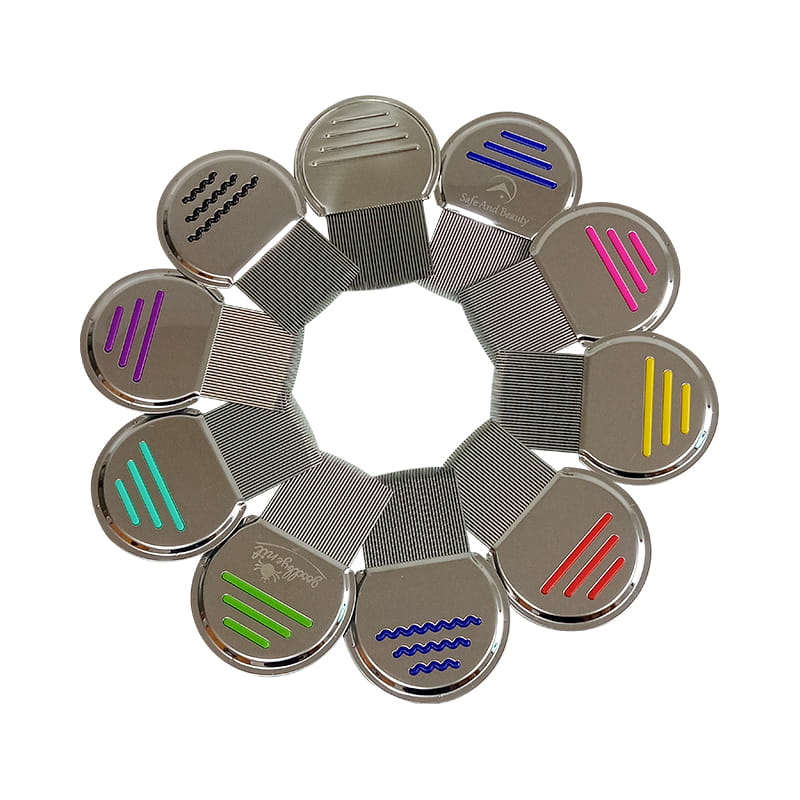Importance of cleaning pet lice combs
Pet lice combs are prone to parasites, hair and dander during use. If not cleaned in time, they are prone to breed bacteria and fungi, affecting the subsequent use effect and may cause pet skin infection. In addition, dirt accumulation will reduce the combing effect of the comb teeth and increase the discomfort of the pet. The cleaning process can effectively remove the attachments, ensure the hygiene of the lice comb, and reduce the risk of cross-infection.
Basic steps to clean pet lice combs
Cleaning lice combs can generally be divided into two parts: physical removal and deep disinfection. First, use gloves or paper towels to clean the hair and parasite residues between the comb teeth. You can use a fine-toothed brush or toothbrush with warm water to brush off surface impurities. Then, soak the lice comb in warm water, add a small amount of pet-specific detergent or mild soap, and soak for 10 to 15 minutes to help break down grease and dirt. Finally, rinse thoroughly with running water and wipe dry with a clean towel or dry naturally.

Differences in cleaning methods for lice combs of different materials
The cleaning methods for pet lice combs of different materials are slightly different. Metal lice combs are water-resistant and corrosion-resistant, suitable for cleaning with warm water and soap, and can also be disinfected with alcohol or disinfectant. Plastic lice combs should avoid high-temperature soaking to prevent deformation or aging. When cleaning, choose a mild detergent and avoid using solutions containing strong acids or strong alkalis. Composite lice combs usually use a gentle detergent according to the specific material composition to avoid soaking for too long and prevent damage to the handle.
Necessity and method of lice comb disinfection
Disinfection is an important part of pet lice comb maintenance, especially in multi-pet households or when pets are infected with parasites. Common disinfection methods include alcohol wiping, ultraviolet disinfection, and hot water soaking. Using alcohol with a concentration of about 70% to wipe the comb teeth and handle can effectively kill bacteria and viruses. The ultraviolet disinfection box is suitable for regular deep disinfection to avoid chemical residues. Hot water soaking should pay attention to temperature control to avoid damage to plastic parts. The disinfection frequency should be adjusted according to the frequency of use and the condition of the pet. It is generally recommended to disinfect at least once a week.
Daily precautions for lice comb maintenance
In addition to cleaning and disinfection, daily maintenance is equally important to extend the service life of the lice comb. After use, the residue should be cleaned up in time to avoid long-term adhesion of dirt. If the teeth of the comb are deformed or broken, they should be replaced in time to avoid harm to the pet. When storing the lice comb, it should be kept dry and ventilated to avoid humid environment causing metal rust or plastic aging. It is recommended to store the lice comb separately to prevent cross-contamination with other tools.
Common misunderstandings in the use and cleaning of lice combs
Many pet owners have misunderstandings when cleaning lice combs, such as using strong chemical detergents to clean, which may damage the material or leave harmful residues. Long soaking time or high-temperature disinfection can easily cause plastic deformation. Incomplete cleaning can lead to parasite residues and bacterial growth. The handle part is neglected to be cleaned, which is easy to become a breeding point for bacteria. The correct cleaning method should avoid these problems and ensure the safe and effective use of the lice comb.
The impact of cleaning and maintenance on pet health
Good cleaning and maintenance habits can reduce the spread of bacteria, parasites and fungi on the lice comb, and reduce the risk of skin infections and allergies in pets. Especially in multi-pet households and environments where pets are susceptible to parasites, keeping the lice comb clean has a positive effect on overall pet health. A clean lice comb can also help improve your pet's grooming experience, reducing discomfort and resistance.
Cleaning and Maintenance Recommendations for Pet Lice Combs
|
Cleaning Step |
Specific Method |
Precautions |
|
Physical Cleaning |
Remove hair and parasite residues using gloves or tissue |
Avoid direct contact with contaminants |
|
Surface Brushing |
Use a fine-tooth brush or toothbrush with warm water and mild detergent |
Avoid vigorous scrubbing to prevent damage to comb teeth |
|
Soaking & Disinfection |
Wipe with 70% alcohol, use UV disinfection, or soak in warm water for 10-15 minutes |
Control temperature and soaking time to prevent material damage |
|
Thorough Rinsing |
Rinse thoroughly with running water to remove all detergent and residues |
Ensure no residue remains to avoid harm to pets |
|
Drying & Storage |
Wipe dry or air dry; store in a dry, ventilated place |
Avoid damp environments to prevent rust or deterioration |




 Español
Español  中文简体
中文简体








